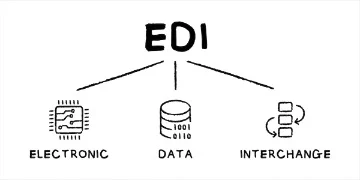As global trade becomes increasingly complex and the volume of business transactions grows, the need for efficient and reliable communication between trading partners is critical. Electronic Data Interchange (EDI) is a technology that has been widely adopted in the logistics industry to facilitate the exchange of business documents and automate supply chain processes. In this article, we will cover everything you need to know about EDI transactions.
Electronic Data Interchange (EDI) is a critical component of the logistics industry, allowing for the seamless exchange of business documents between trading partners and logistics companies. EDI technology provides a standard electronic format for the exchange of information, eliminating the need for phone calls, faxes, and paper-based documents. The entire process of EDI work can be automated, reducing the risk of human error and saving time for businesses.
What is EDI (Electronic Data Interchange)?
As mentioned, Electronic Data Interchange (EDI) is the electronic exchange of business documents between trading partners in a standardized format. EDI has been around since the 1960s, but it was not until the 1980s that it became widely used in the logistics industry. Today, EDI is used by companies of all sizes, from small businesses to large multinational corporations.
EDI transactions typically involve the exchange of documents such as purchase orders, invoices, shipping notices, and inventory reports. By using standardized formats, EDI transactions can be processed automatically by computer systems, eliminating the need for manual data entry and reducing errors.
How does EDI work?
EDI transactions are typically initiated by one trading partner sending a document to another trading partner using a secure network connection. The document is transmitted in a standardized EDI format that is agreed upon by both parties. The receiving partner’s computer system then processes the document automatically, updating the relevant databases and generating any necessary responses.
EDI transactions can be initiated in a variety of ways, including the direct connection between trading partners, through a third-party service provider, or via the internet using protocols such as AS2 (Applicability Statement 2).
What are the benefits of using EDI?
There are many benefits to using EDI in logistics and supply chain management, including:
- Efficiency: EDI transactions can be processed automatically, reducing the time and effort required for manual data entry and document processing.
- Accuracy: By eliminating the need for manual data entry, EDI can significantly reduce errors in the supply chain process.
- Cost savings: Automating supply chain processes with EDI can reduce labor costs and eliminate the need for paper documents, which can be expensive to produce and store.
- Improved visibility: EDI transactions can provide real-time visibility into the status of orders, shipments, and inventory, allowing companies to make better-informed decisions and respond more quickly to changes in demand or supply.
- Faster order fulfillment: By automating supply chain processes, EDI can speed up order fulfillment times, improving customer satisfaction and reducing the risk of stockouts.
What are Some Common EDI Transaction Sets Used in Logistics Between Trading Partners?
EDI transaction sets are standardized formats for specific types of business documents. The most commonly used EDI transaction sets in logistics and supply chain management include:
- EDI 810 – Invoice: Used to request payment for goods or services.
- EDI 850 – Purchase Order: Used to request goods or services from a supplier.
- EDI 856 – Advance Shipping Notice: Used to notify a recipient that a shipment is on its way.
- EDI 940 – Warehouse Shipping Order: Used to request that goods be shipped from a warehouse.
- EDI 945 – Warehouse Shipping Advice: Used to notify a recipient that a shipment has been sent from a warehouse.
Understanding EDI Codes
EDI codes are used to identify specific data elements within an EDI transaction. They are unique to each EDI document type and help ensure the accurate transfer of data between systems.
EDI Transaction Codes
EDI transaction codes are used to identify specific transactions within an EDI document. They help ensure the accurate exchange of business data between systems and are critical to the success of EDI transactions. Some of the most common EDI transaction codes include 810 (Invoice), 856 (Advance Ship Notice), and 850 (Purchase Order).
EDI Numbers
EDI numbers are unique identification numbers assigned to each EDI transaction. They help track transactions and ensure that the correct information is being exchanged between systems. EDI numbers can be assigned by either the sending or receiving system and are usually created using a combination of letters and numbers.
EDI Standards List
An EDI standards list provides an overview of the different EDI standards used in warehouse management. These standards help ensure the accurate exchange of information between systems and are critical to the success of EDI transactions. Some of the most common EDI standards include UN/EDIFACT, ANSI X12, TRADACOMS, and EDIFACT.
EDI Transaction Sets
EDI transaction sets help to ensure the accurate exchange of business data between logistics companies and their trading partners. Some of the most common EDI transaction sets include purchase orders, invoices, and advance ship notices. These transaction sets provide a standard format for the exchange of information, reducing the risk of errors and improving the speed of the transaction process.
EDI Solutions for Logistics Companies
EDI communication allows logistics companies to integrate their systems with their trading partners, improving their efficiency, accuracy, and customer satisfaction. EDI software and solutions can automate many of the manual processes involved in EDI transactions, improving the accuracy and speed of the transaction process. Logistics companies can implement EDI in-house or integrate with EDI service providers to streamline their operations.
EDI Documents List
An EDI documents list provides a comprehensive overview of the different types of EDI documents used in warehouse management. This list can be used to identify specific EDI documents and ensure the accurate exchange of information between systems. Some of the most common EDI documents include invoices, purchase orders, and advance ship notices.
EDI Document Types
EDI document types are used to identify specific types of EDI transactions. They help ensure the accurate exchange of information between systems and are critical to the success of EDI transactions. Some of the most common EDI document types include invoices, purchase orders, and advance ship notices.
EDI Transaction Types
EDI transaction types are used to identify specific types of EDI transactions. They help ensure the accurate exchange of business data between systems and are critical to the success of EDI transactions. Some of the most common EDI transaction types include purchase orders, invoices, and advance ship notices.
EDI Integration
EDI integration is the process of integrating EDI technology into a company’s existing systems to facilitate the exchange of information. By implementing EDI solutions, logistics companies can improve their efficiency, accuracy, and customer satisfaction. EDI transactions ensure the accurate exchange of information between logistics companies and their trading partners, improving supply chain management.
Ready to Streamline Your EDI Processes?
Discover how SphereWMS can enhance your EDI transactions for improved efficiency and accuracy in your supply chain operations. Our advanced EDI integration ensures seamless communication and real-time data exchange, helping you meet modern logistics demands.
Explore EDI SolutionsSphereWMS: Warehouse Management Software and EDI Transactions
SphereWMS is a cloud-based warehouse management system (WMS) designed to optimize and streamline warehouse operations. It integrates with various EDI systems and automates many of the manual processes involved in EDI transactions.
How SphereWMS Enhances EDI Transactions in Warehouse Management
SphereWMS helps organizations manage their EDI transactions effectively by offering features such as:
- Automated EDI Mapping and Translation: SphereWMS automates the mapping and translation of EDI data, eliminating the need for manual data entry and reducing the risk of errors.
- Real-time EDI Document Tracking and Monitoring: SphereWMS provides real-time tracking and monitoring of EDI documents, allowing organizations to quickly and easily track the status of their EDI transactions.
- Accurate Inventory Tracking and Management: SphereWMS accurately tracks inventory levels, helping organizations better manage their stock levels and ensure they can always meet customer demands.
- Improved Accuracy and Speed of EDI Transactions: SphereWMS streamlines the EDI transaction process, improving accuracy and reducing the time it takes to complete transactions.
- Enhanced Visibility into the EDI Transaction Process: SphereWMS provides organizations with enhanced visibility into the EDI transaction process, helping them better understand and manage their EDI transactions.
Conclusion
EDI transactions are a vital component of modern warehouse management, enabling the seamless exchange of business data between different organizations. Understanding EDI codes, numbers, document types, and transaction sets are essential for warehouse operators to ensure the accurate exchange of information between systems and improve overall efficiency.
SphereWMS is a powerful warehouse management tool that helps organizations streamline and optimize their EDI transactions. By leveraging SphereWMS’s features, organizations can improve the accuracy and speed of their EDI processes, while also gaining valuable insights into their transactions. With SphereWMS, warehouse operations can be streamlined and simplified to save time and money, while also improving customer satisfaction.
To learn more about how SphereWMS can benefit your organization, contact us today. With SphereWMS, you can streamline and optimize your EDI transactions, saving time and money while improving efficiency and customer satisfaction.
FAQ
What Industries Typically Use EDI?
EDI is widely used in logistics and supply chain management, including industries such as retail, manufacturing, healthcare, finance, and government agencies.
What Are Some Common Challenges of Implementing EDI?
Some common challenges of implementing EDI include the initial cost of setup and implementation, the need for ongoing maintenance and updates, the need for skilled staff to manage the system, and the need for secure and reliable network connections between trading partners.
How Can EDI Benefit Small Businesses?
EDI can benefit small businesses by reducing the need for manual data entry and document processing, improving the accuracy and speed of transactions, and reducing labor costs. By automating supply chain processes, small businesses can also improve their competitiveness and increase customer satisfaction.
Is EDI Secure?
EDI transactions are typically transmitted using secure network connections and encrypted data, making them highly secure. However, as with any electronic communication, there is always a risk of data breaches or cyber attacks, so it is essential to implement robust security measures to protect sensitive information.
Can EDI Integrate with Other Systems?
Yes, EDI can integrate with other systems, such as warehouse management systems (WMS), enterprise resource planning (ERP) systems, and customer relationship management (CRM) systems. By integrating with other systems, companies can improve their efficiency, accuracy, and overall supply chain management.








